6 REGIONS OF PERU
Lima, Nasca & South Pacific – Arequipa & Colca canyon – Titicaca lake – Cusco – North – Amazonia
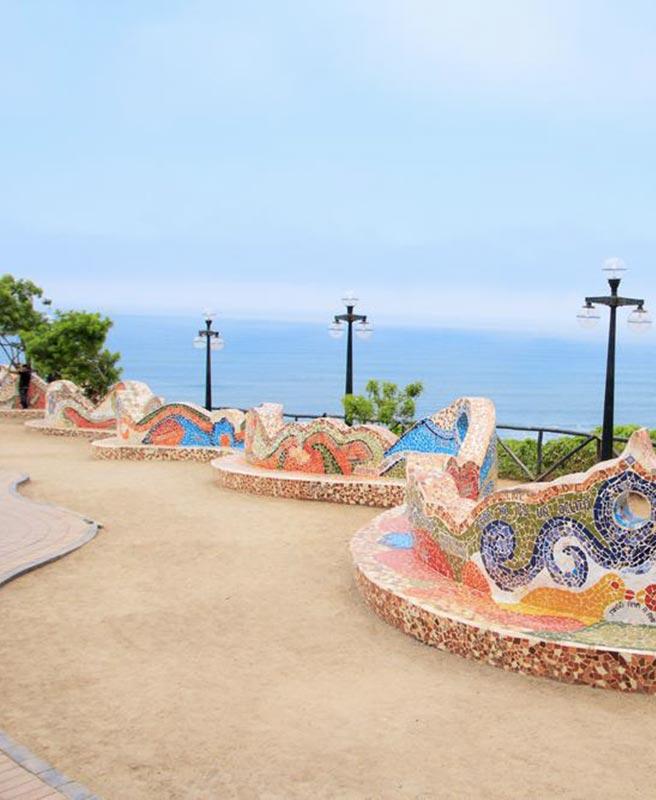

Lima
Lima was founded by Francisco Pizarro in 1535 and its historical center is part of the UNESCO World Heritage site as it was preserved almost intact. Around the historical center the city has been developed by the nearby desert and also on the Pacific Coast. As of today it has more than eight million inhabitants.
THE HISTORICAL CENTER spreads out around the square called plaza de Armas embellished by a bronze fountain from 1650. The Government Palace, the Cathedral and the beautiful palace of the Archbishopric with its vast balcony in carved wood. Moreover, the entire historical center is made up of residences with wood balconies, some of them are highly decorated and very well-preserved since rain is rare in Lima.
Among the most beautiful ancient residences in Lima, let’s cite Palacio Torre Tagle, la Casa Pilatos and la Casa de Riva.
NOT TO BE MISSED :
- Saint François Monastery (17th and 18th centuries) to visit for its baroque architecture, cloister, library and impressive catacombs. Other religious buildings: Santo Domingo and San Pedro churches.
- Los Descalzos monastery-museum for the visit of the kitchens, the refectory and the monks’ cells.
- La plaza San Martin – the liveliest part of the city to meet Lima’s population.
- THE BARRANCO NEIGHBORHOOD – This former neighborhood has become very trendy with the establishment of the MATE museum dedicated to young talents and to the work of the photographer Mario Testino. 19th century residences, restaurants and stylish bars. It is also the antiquarian district.
- SAN ISIDRO NEIGHBORHOOD – The Larco Museum hosts an exceptional collection of potteries, fabrics, jewelry and ritual objects dedicated to the Peru first great civilizations, mostly coming from North country: Mochica, Chimu, Moché. The museum has a cozy restaurant and magnificent gardens.
- MIRAFLORES NEIGHBORHOOD – located on the Pacific Coast, it is the posh neighborhood of the city and where most of the hotels, restaurants, bars, luxury boutiques are located and all of this with a spectacular Pacific Ocean panoramic view.
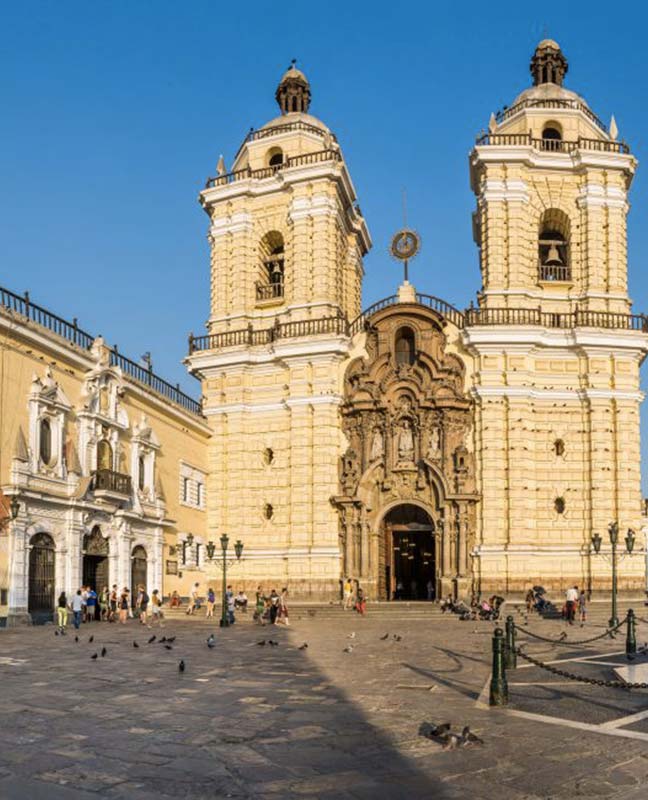


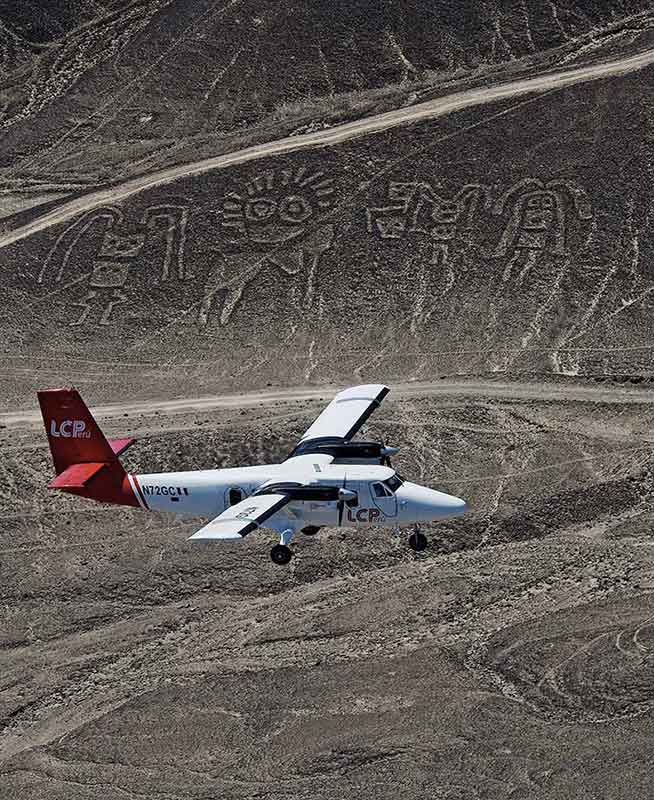
LEAVING Lima
THE SOUTHERN COAST
Overlooked by the desert sand dunes framing the Pacific, the southern coast is peppered with cities and villages often as oases.
Pisco, Paracas, Ica and the vineyards where you can enjoy Peruvian wine-tasting. A boat tour not to be missed to discover the Ballestas Islands and watch sea birds, sea lions and Humbolt penguins.
Nasca protects drawings of magic birds and sacred animals plotted on the desert from the civilization with the same name. The drawings are from 30 to 40 m long and can be seeing from a 3 to 9 seats light aircraft. The best time recommended is either the morning or the end of afternoon.
Booking your flights is highly recommended especially during peak season. These drawings express the worship of the Nasca people for the constellation and stars. According the scientist Paul Kosok, Nasca is “the greatest book of astronomy of the world” as for him each drawing is a pictorial representation of the sacred stars.
Between Lima and Nasca, the PanAmerican road meanders through the desert. After having enjoyed the beautiful ocean and sand dune scenery, you will take the road towards the Andean mountains to Arequipa.
Arequipa
Joyful colonial city, Arequipa is one-hour flight away from Lima, with several daily flights, and connected to Cuzco as well as Juliaca/Puno. Note that you can access to Juliaca/Puno via land through Altiplano – approximatively 7 to 8 hours time.
Arequipa, located at the bottom of El Misti volcano and at 2,200 m of altitude, brightens by its architectural structure built in an exquisite colonial style. This set of buildings can be split into two parts:
- The historical center formed by residences, churches and monasteries built with volcanic grey-white color stone and always with vibrant activities.
- 17th century Santa Catalina monastery, real citadel in the city, with residences and buildings painted in blue, pink and ocher colors, and where silence prevails.
Not to be missed:
- La Plaza de Armas, heart of the city, where the gigantic cathedral looms. The square is surrounded by shopping streets with many restaurants and coffee houses.
- Santury museum where the mummy called “Juanita” is preserved, young Inca sacrificed with burial objects.
- The monastery and the Santa Teresa sacred art museum (17th century), magnificently restored.
- Arequipa’s tasting of typical dishes often spicy and the “picanterias”, typical restaurants of the city.

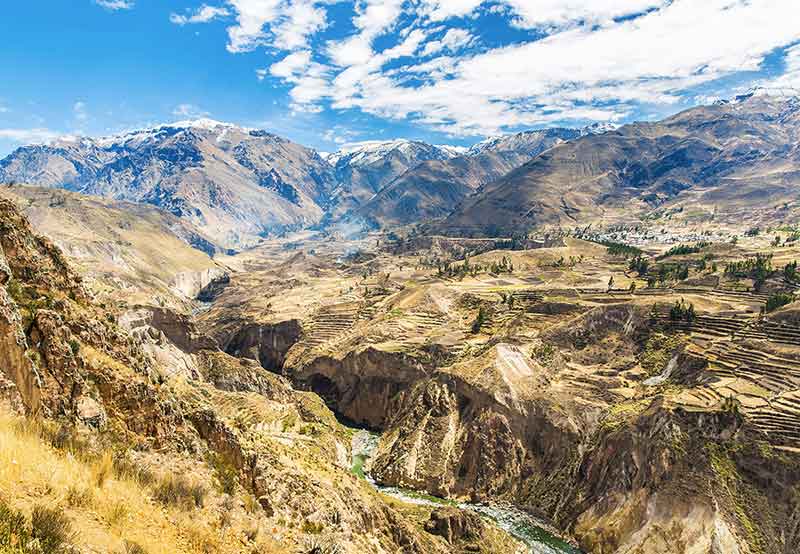
Leaving Arequipa, the canyons region in the Andean high mountains offers spectacular landscapes where traditional calm villages are worth a look. The most famous canyon is without doubt the Colca approximately 4 hours away from Arequipa.
Not to be missed:
- Observing terrace cultivations set against the Andes foothills.
- The Chivay village and its market.
- The Cruz del Condor where an important condors’ colony, the icon bird of Andes, lives on a rocky peak. Sumptuous setting overlooked by the Misti volcano.
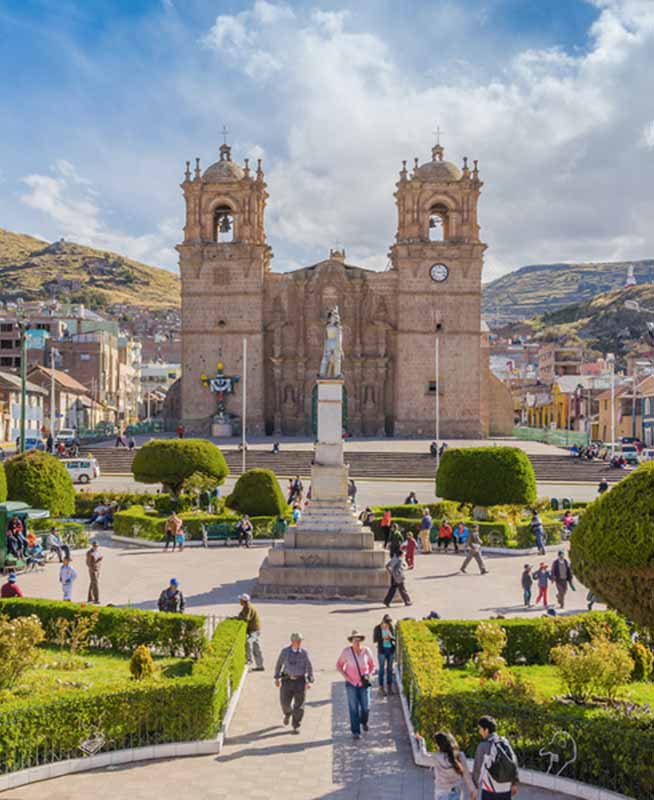

Puno
Juliaca airport is one hour away from the lake with the main city Puno where you can find most of the hotels. Some facilities are built on the shores of Lake Titicaca offering rooms with a magnificent view.
Juliaca has also a railway station with a train that connects the lake region to Cuzco (approximately 8 hours). This trip can be done by bus which provides the benefit of stopping in some of the Altiplano villages.
Puno is recognized by its traditions and popular celebrations of significant importance.
Note that the Virgen de la Candelaria celebration (February first fortnight), a mix of indigenous and catholic rituals.
A big market takes place every Saturday.
Uros
Tours are planned every day for sightseeing on the lake. The most extensive is the floating islands visit then Taquile.
Floating Islands – the islands shelter Uros people, they live mainly from the tourism thanks to their unusual habitat. These are artificial islands built with light reeds called “totora”. Not only the islands but also houses, boats and objects of the daily life are woven with reed….. Uros have been living like this for centuries when they had to invent this way of life in order to survive from the attacks of their opponents.
Taquile Island – a rock anchored in the middle of the lake with a wonderful view on the Cordillera Real. The quechua language community lives on the summit of the island. Agriculture and manufacture of exquisite colored fabrics are the backbone of their economy. You can stay overnight in private homes with locals in Taquile and enjoy this village special atmosphere. Family restaurants are also made available to travelers.
Amantani Island – To visit this island you must stay overnight in private homes with locals. Strongly influenced by the Aymara culture, the locals live in 8 small villages in adobe homes. Beautiful landscapes with lake and snowy mountains.
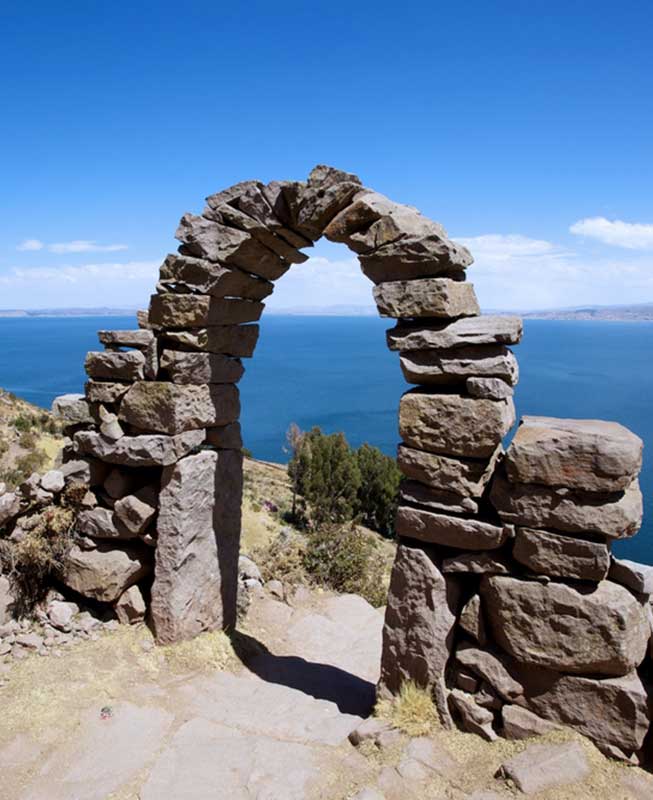



Cusco
According to Pablo Neruda, Cuzco is the “beating heart of Latin America”. The ancient capital of the Inca empire, designated World Heritage of Humanity, located at 3,400 m of altitude, is accessible by plane departing from Lima and Arequipa and by train as well as by bus departing from Juliaca/Puno.
You need at least 4 full days to visit Cuzco and its surroundings.
The city stands dignified at the bottom of an Andean valley and the edges of its domes and monuments are impressive. Several religious and profane celebrations are held in Cuzco of which Holy Week and the one of Inti Raymi, 24 June, the winter solstice celebration.
NOT TO BE MISSED :
La Plaza de Armas – as most of the city of Cuzco, this square already existed during the Inca period. After the Spanish colonization, galleries and the current architecture was added. Surrounded by many restaurants, bars and boutiques.
Two remarkable religious monuments stand on the square: the Cathedral – 17th century – which gathers a precious collection of paintings from the Escuela Cuzquena, sacred art school created in Cuzco and based on Spanish and Indigenous influences.
Jesus Companionship church – as some of the buildings in Cuzco, the 16th/17th century church was built on the basis of an Inca palace. The front and inside are richly decorated in a pure baroque style.
Coricancha – at the bottom of the main Inca temple, colons have built the church and the Dominican Monastery. The monument is the most emblematic of the city and symbolizes the creation of the Spanish Language Latin American culture based on the indigenous and Spanish influences.
San Blas neighborhood – for a walk through the lively streets and the visit of boutiques and artists’ shops.
La Merced – recently restored, this church holds the most beautiful cloister of Cuzco.


LEAVING
Cusco
Machu Picchu – you can access to the most mysterious site of the entire Latin America by trains leaving from Cuzco station to Aguas Calientes station (3 hours trip along the sacred Inca river, the Urubamba). From Aguas Calientes buses tours take you to the site entry open everyday from 8h to 17h. It can be visited in one-day return tour or even staying overnight in one of the many hotels in Aguas Calientes.
Next to the Cuzco station, San Pedro covered market is a recommended stop for the colors and the flavors.
Machu Picchu site is located in an amphitheater formed by mountains, canyons and faces the Amazonian jungle. The citadel discovered in 1910 seems to be carved around the mountain surrounded at the bottom of the gorge, through the Urubamba river.
Temple? Palace? Lost village? Machu Picchu origins remain a mystery. However, the ruins of the city show the Inca architecture style.
You can discover Machu Picchu site doing a trek through the site called “the Inca Path” for 2 or 3 days.


The Incas Sacred valley – crossed by the meanderings of the Urubamba river, this beautiful valley hosts many small villages and archaeological sites. It is a place to stay and to discover where you need to spend at least one night.
The Maras Salins – always in activity, it is still a gem salt extraction from the Pre-Inca period. More than 40,000 salt wells provide wealth to the inhabitants of the nearest village of Maras.
The Chinchero market – Sunday meeting place for the indigenous communities coming to sell/buy agricultural products from Altiplano. Not to be missed the service in the village church early in the morning.
Ollantaytambo – Last Inca bastion, fortress and ceremonial center, a place which shows the Inca military architecture. Next to the fortress, Ollantaytambo village keeps its urban map from the Inca period.
Pisac – daily crafts market and greater archaeological site.
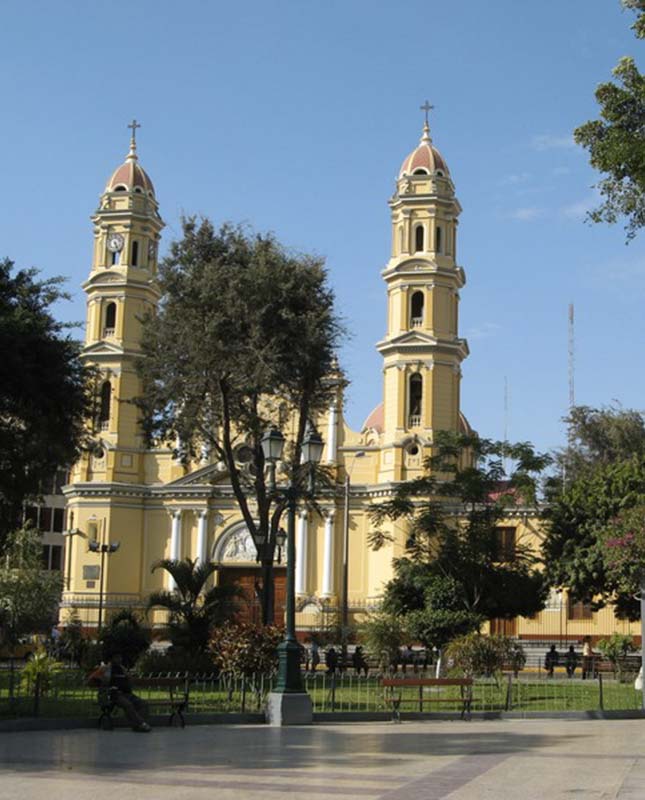
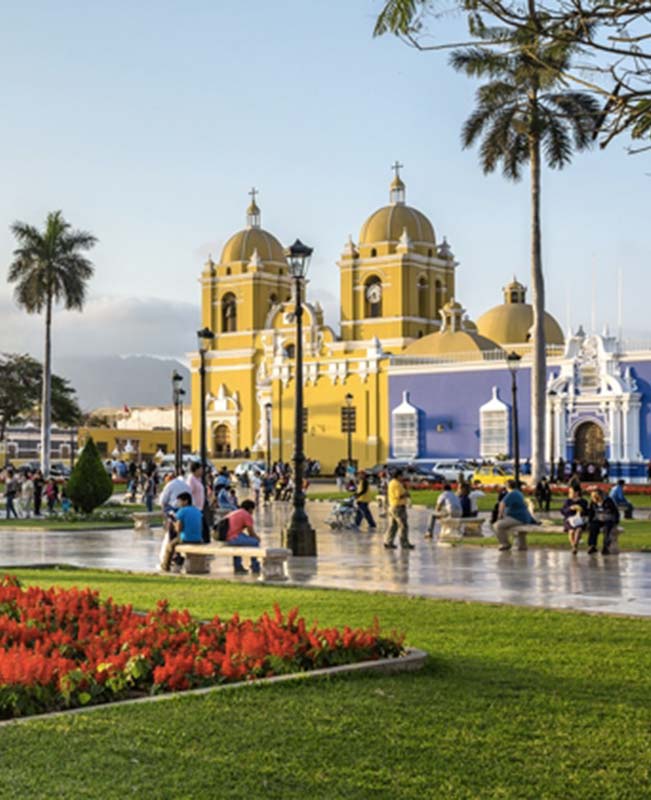
Trujillo & Chiclayo
Still unknown and not very visited, the North of Peru keeps millenary vestiges of civilizations some colonized by the Incas.
The Pacific coast, the desert dunes, and the vertiginous cliffs offer an impressive picture where adobe citadels are visible. However, here the imagination and the motivation of the passionate traveler of archaeology will always be tested to be able to seize the region sumptuousness.
Trujillo and Chiclayo, reachable by one hour approximately daily flights leaving from Lima, are the main cities in the North. Trujillo has known to keep its rich colonial heritage where the Spanish influence is very present. Squares, churches and residences with iron balconies form the historical center.
Glimpse at the Cassinelli private museum with a precious collection of archaeological objects.
LEAVING Trujillo
Mochica and Chimu civilizations have left important vestiges very closed to Trujillo.
Chan Chan – the biggest pre-Colombian city known for the vestiges spread in a large space. The two sites to visit are the Huacas Esmeraldas and the Arco-Iris without forgetting the archaeological museum.
Huacas del Sol y de la Luna – Mochica archaeological sites dedicated to the Sun and the Moon and also the site El Brujo with its wonderful low landforms.
Leaving Chiclayo – the city of Chiclayo is known for its welcoming style always very kind and for its shamans. Look around the market – Mercado Modelo, is worth it with many medicine plants and elixirs used by the “brujos” – shamans.
For archaeology amateurs, the surroundings of Chiclayo offer the greater site of Sipan with its tombstones in adobe. The place became famous with the discovery of the tombstone of a great Lord Mochica who has helped the progress of the awareness of this civilization. The tombstones of the site are all restored as they were partially devastated by the pillage of the huagueros.
To be noted that it is in Lambayeque – 30 minutes away from Chiclayo – that you can admire the pieces found on the Sipan tombstones. Two remarkable museums that deserve a thorough visit: The Royal Tombstones Museum in Sipan with marvels in ceramics and gold. Very close the Bruning museum presents archaeological objects collections from the Chimu, Mochica, Chavin and Vicus cultures.
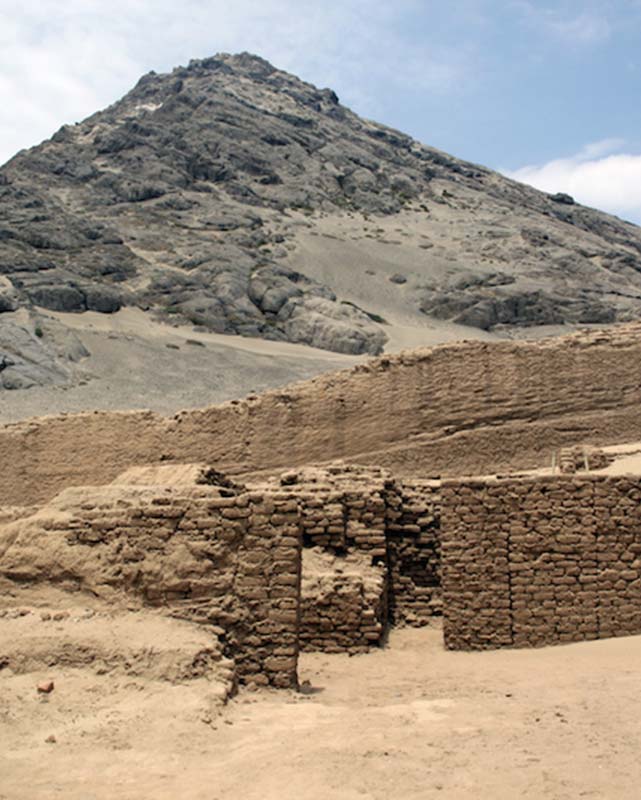
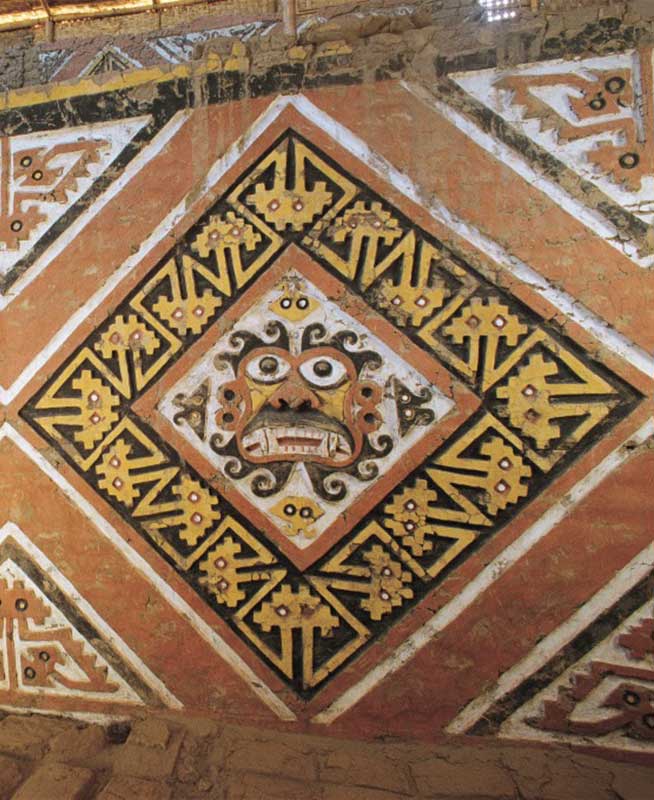
Iquitos
Almost 50% of the Peruvian territory is covered by the Amazonian basin and its weak ecosystems. Two cities are the privileged entry point to discover the Amazonian jungle:
Iquitos located North of the country and accessible by plane leaving from Lima. Located by the Amazonian border, the city keeps still some reminiscences of the rubber period and a market, the Belen, which seems to abound of the most exotic fruits, vegetables and meats. Departing from Iquitos it is possible to do cruises on the Amazonia until Manaus and Belém in Brazil. For accommodation, the lodges in the forest are the best option to discover Amazonian wildlife and flora.


Puerto
Maldonado
Puerto Maldonado located southeast, 45 minutes’ flight from Cuzco, it is the most and fast accessible part of the country of Amazonia and full of natural resources. The Peruvian government conducts a policy of nature protection which really helped the region preservation. Environment-friendly lodges have been installed in the jungle which provides 2 or 3 days’ stays of premium quality.
Navigating on Madre de los Dios and the Tambopata, it is possible to access these lodges in routes of 2 to 3 hours and explore the jungle with forest guides. Not to be missed the Manu National Park which gathers quantity of birds and other animals of Amazonia.


